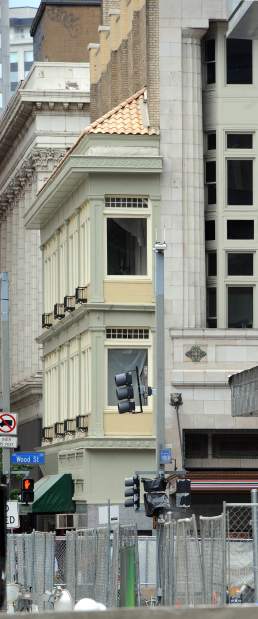Skinny Building in Downtown Pittsburgh granted a fresh face
Louis Hendel paid $65,000 in 1918 — the equivalent of $1.02 million in 2015 dollars — for a 6- by 80-foot sliver of vacant Downtown property and built a “tiny skyscraper” to house one of his fruit-and-vegetable stores.
Family members said Hendel built the structure “out of spite” because local businesses, including a jewelry store next door, objected to his selling produce from the sidewalk.
“That was the No. 1 store,” said Janice Walker, 73, of Denver, granddaughter of Louis Hendel. “I do remember that either during (World War II) or the Depression that store sold thousands and thousands of rabbits. They would skin the rabbits there and sell them.”
The property at Forbes Avenue and Wood Street, eventually dubbed the “Skinny Building,” stands on what was a hot piece of real estate at the beginning of the 20th century.
Andrew W. Mellon of Mellon Bank fame, who sold the narrow lot to Hendel, paid $40,000 for it in 1907, Allegheny County real estate records show.
A 1926 newspaper story recounted how Louis Hendel and Sons, a Pittsburgh company that operated movie theaters and produce markets, obtained a building permit for what the writer dubbed a “tiny skyscraper” and “dollhouse skyscraper.”
Plenty of Pittsburghers remember the place as Raywell's Restaurant, which served Coney Island-style hot dogs and hamburgers with a unique combination of spices for more than 40 years.
“That was kind of like an indigestion institution in Pittsburgh,” said Chuck Koval of South Park. “Hamburgers were like three for 50 cents or so, and that whole corner just reeked of that odor.”
Gloria Andreozzi, 68, of Bradford Woods said her late father, Ray Roman, operated the hamburger stand there with brother Sotero Roman and other partners from about 1938 until 1979.
She said two Pittsburgh men recruited her dad, who was a cook at New York's Coney Island, to open a restaurant in the Steel City. The 5-foot-2-inch wide interior was a tight squeeze.
The first-floor restaurant had a grill in the corner, a counter, a set of stools and glass doors that patrons would enter. Each glass door opened to a stool, and customers had barely enough room to sit without a door hitting their behinds. Waitresses had about 18 inches behind the counter.
“There were always two waitresses, one for each side,” Andreozzi said. “The waitress on the right had to pass everything to the waitress on the left. You couldn't pass anybody.”
Andreozzi's cousin, Ray Roman, 82, of Emsworth said he would travel to Pittsburgh from Brooklyn in summers to work peeling onions for his dad and uncle Ray.
“I couldn't come up with any way of sitting there and not crying,” he said.
The second floor and basement were for food storage and preparation. The second floor housed the office. Employees changed clothes on the third floor.
Andreozzi said chain burger joints cut into profits and the family sold the business in 1979. The building has since operated as various clothing and food kiosks and now houses a clothing stand.
The Pittsburgh History and Landmarks Foundation in 2014 partnered with the city and the Pittsburgh Urban Redevelopment Authority to renovate exteriors of the Skinny Building and next door John M. Roberts and Son Co. jewelers.
The URA, which owns both buildings, bought them in 2013 for $1.3 million.
Bob Bauder is a staff writer for Trib Total Media. He can be reached at 412-765-2312 or bbauder@tribweb.com.



